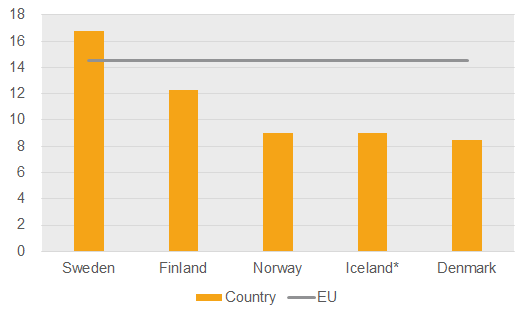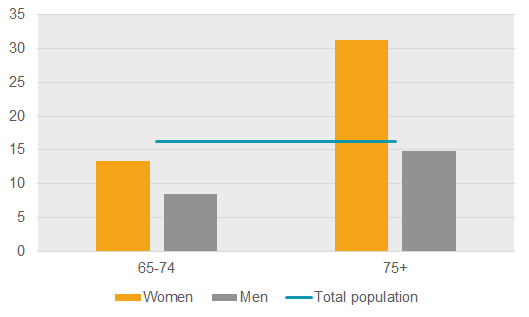Living Conditions Survey (ULF/SILC):
Higher share of people aged 65 and above on low incomes in Sweden compared to the rest of the Nordic countries
Statistical news from Statistics Sweden 2017-10-25 9.30
One in seven of Swedes aged 65 and above has a disposable income that is below the at-risk-of-poverty threshold. This is higher than the share among people aged 65 and above in the other Nordic countries.
Among the Nordic countries Sweden has the highest share of people aged 65 and above with a disposable income below the threshold for being at risk of poverty. 17 percent of Swedes aged 65 and above have a low disposable income compared to between 9 and 12 percent in the other Nordic countries.
According to the EU definition persons at risk of poverty are those living in a household with a disposable income (after social transfers) per consumption unit of less than 60 percent of the median income for all persons in the country.
14 percent of the EU population aged 65 and above has a disposable income below the at-risk-of-poverty threshold.

Source: Eurostat, EU-SILC
* Information regarding Iceland refer to 2015, since information regarding 2015 was not available at the time of publication.
It is more common for people aged 75 and above to have an income below the at-risk-of-poverty threshold. One in four aged 75 and older has a low disposable income compared to one in nine aged between 65 and 74.
Older women are at risk of poverty to a greater extent than older men. Roughly one in three women aged 75 and above compared to one in seven men in the same age group. Contributing factors include the fact that almost every other woman aged 65 years and over is living alone compared to just over every fourth man in the same age group, and that women's pensions are generally lower than men's.

Source: Statistics Sweden, Living Conditions Survey (ULF/SILC)
Other results from EU-SILC
- Three percent of Swedes state that they have great difficulty in meeting the household budget, in line with the share in the other Nordic countries. The corresponding figure for the EU is 10 percent.
- 22 percent of the households’ disposable income is used to pay for housing costs in Sweden, approximately corresponding to the EU average.
- 9 percent of foreign born Swedes experience material deprivation compared to 2 percent of Swedes born in Sweden with both Swedish-born parents.
Definitions and explanations
According to the EU definition persons at risk of poverty are those living in a household with a disposable income (after social transfers) per consumption unit of less than 60 percent of the median income for all persons in the country. For a single person the at-risk-of-poverty threshold was 141 224 SEK in 2016 and for a couple without children 211 836 SEK.
The indicator Difficulty in making ends meet is one of the indicators used to follow up how households meet economic strains. The share is estimated from those who answered "great difficulty" to the question "If you look at your household finances on the whole, do you think it is easy or difficult (for you) to make ends meet?".
Material deprivation is measured by studying if people can pay for unexpected expenses, afford one week's holiday per year away from home, eat meat, fish or a protein equivalent every other day, keep home adequately warm, have a washing machine, a colour TV, telephone or car, or being confronted with payment arrears (mortgage or rent, utility bills, hire purchase instalments or other loan payments). A person who is materially deprived cannot afford at least three of these nine items.
More about the statistics
The EU-SILC (EU Statistics on Income and Living Conditions) is a statistical survey that is conducted annually in the EU countries as well as several other countries. Since 2008, the survey has been a part of the Survey on Living Conditions, enabling us to make international comparisons. More results are presented on Statistics Sweden's website:
Living Conditions Surveys (ULF/SILC)
Detailed information about the EU-SILC is available on Eurostat's website:
Statistical Database
More information is available in the Statistical Database
Feel free to use the facts from this statistical news but remember to state Source: Statistics Sweden.
